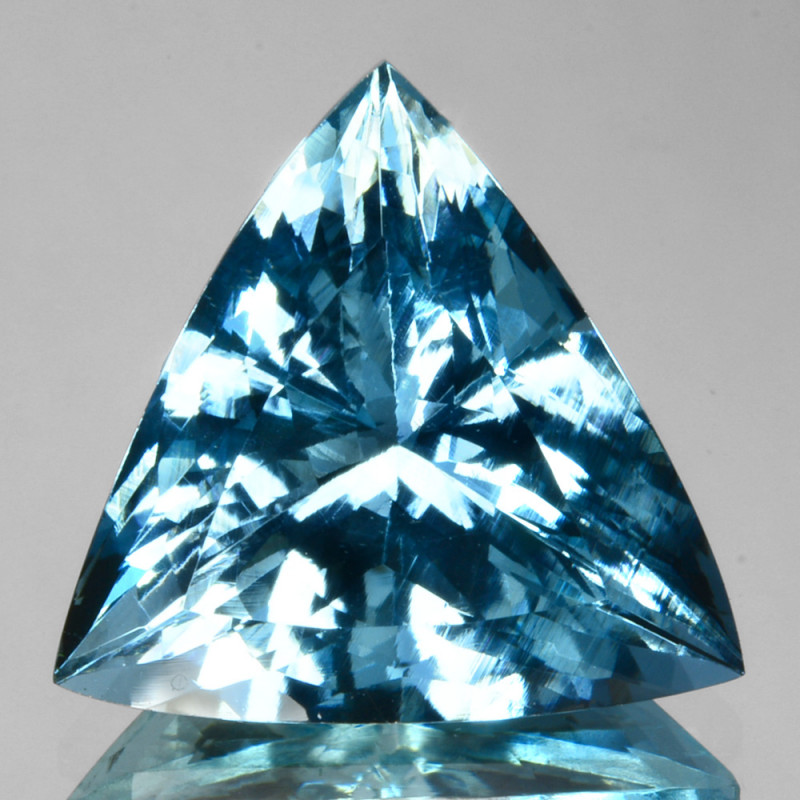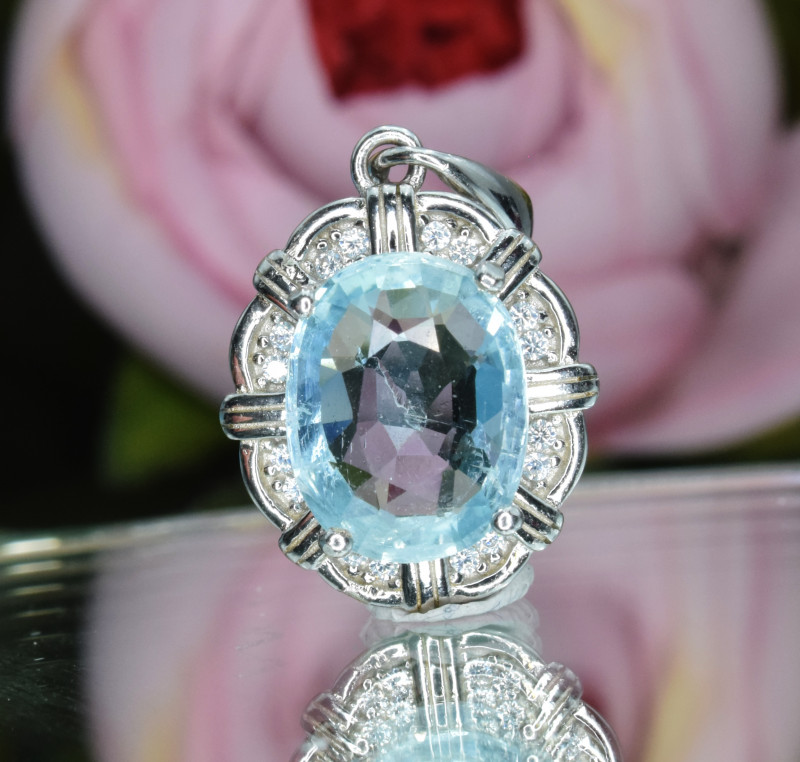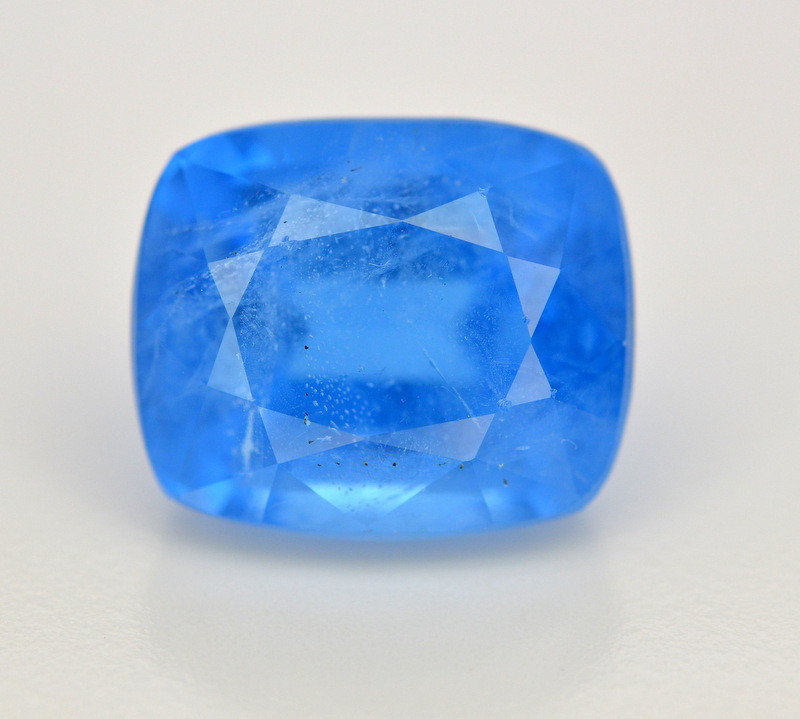
Aquamarine Gemstone: Properties, Meanings, Value & More
 Aquamarine is a light-colored blue to blue-green beryl stone popular for its brilliant clarity and connection to the sea. Used for centuries, aquamarine has made an impact worldwide as an influential gemstone.
Aquamarine is a light-colored blue to blue-green beryl stone popular for its brilliant clarity and connection to the sea. Used for centuries, aquamarine has made an impact worldwide as an influential gemstone.
From the Santana song to the software application, aquamarine’s beauty has inspired titles across the board. Some mining locales take such pride in their aquamarines, they’ve named it their official gemstone, like the US state of Colorado.
Victoria’s Secret brought the stone further fame in 2011 when that year’s “Fantasy Treasure Bra” featured aquamarine alongside pearl and citrine.
So, does aquamarine live up to the hype? What mysteries swim beneath the surface of this oceanic gem? Read on to find out!

About Aquamarine Stone
Aquamarine is a subtle-toned blue to blue-green gemstone known for bringing good fortune to anyone who wears it.
Those with March birthdays are particularly lucky to have an aquamarine birthstone!
What zodiac is aquamarine good for? Well, if you’re a Pisces born in March, you’re extra fortunate to have aquamarine as your star stone and birthstone.
Additionally, those born under Gemini or Scorpio are blessed with aquamarine as one of their zodiac stones. Under the Chinese zodiac, aquamarine belongs to birthdays during years of the ox.
Aquamarine is also the traditional gemstone for 19th wedding anniversaries! Many couples may own the gem already, since opting for aquamarine rings over diamonds as an engagement stone has become popular. If that’s the case, gifting new aquamarine jewelry to match is a perfect way to celebrate how far you’ve come.
Mineral Characteristics
With all the references outside of gemology, you may wonder: Is aquamarine a real gemstone? Yes, it is!
Aquamarine is a beryl mineral found in pale tones of blue or greenish-blue. If you’ve heard of emerald or morganite, those are both beryl stones. Chemically, aquamarine is made of beryllium, aluminum, and silica.
On the Mohs mineral hardness scale, aquamarine ranks at an impressive 7.5 to 8. Combined with its lack of cleavage, aquamarine is one of the most durable stones around.
The list of impressive traits begs the question: Is aquamarine a rare gem?
Aquamarine isn’t incredibly rare, as lighter-hued specimens with greener undertones are fairly common and huge aquamarine crystals have been discovered. High-quality blue aquamarine is rarer, but we’ll go into more detail on that later.
 Image: Maxixe aquamarine
Image: Maxixe aquamarine
Aquamarine Varieties
There are quite a few other names for aquamarine gemstone, and some describe specific varieties:
Espirito Santo: Very rare variety from Brazil’s Espirito Santo state with a one-of-a-kind brilliance and low-intensity blue coloring.
Pedra Azul: Icy-blue variety only found as small specimens in Brazil’s Pedra Azul district.
Nampula: Aquamarines with a robin’s-egg blue tone found in the Nampula province of Mozambique.
Maxixe or Blue Beryl: Rare variety found in Brazil’s Maxixe mine with a rich, saturated blue coloring caused by nitrate and natural irradiation, rather than iron, though its color may fade with light exposure.
Moss Aquamarine: Modern trade name for low-quality B to C grade aquamarine with greener hues that is heavily included and shows iron speckling.
So, what traits are used to identify aquamarine? Check them out below!

Aquamarine Specifications & Characteristics
Color: Blue to greenish-blue; Typically pale, but can be intensely saturated
Crystal structure: Hexagonal
Luster: Vitreous (glass-like)
Transparency: Transparent to translucent
Refractive index: 1.57-1.59
Density: 2.65-2.85
Cleavage: None
Fracture: Conchoidal
Streak: White
Luminescence: Weak; Green LW, Green or very pale blue SW
Pleochroism: Present but weak; Nearly colorless and intense blue
That’s enough science for now; let’s get into symbolism!

Aquamarine Stone Meaning
The name aquamarine comes from the Latin aqua, meaning “water,” and marine, meaning “the sea.” Together, the name translates to “sea water,” for the stone’s resemblance to the greenish-blue of shallow ocean waters.
With that in mind, what does aquamarine symbolize? Simply put, aquamarine symbolizes serenity, rebirth, protection, and the passion of young love.
Legends that contributed to aquamarine spiritual meaning mostly revolve around the sea. (Shocker, right?) However, themes of love, joy, and divinity are present throughout many interpretations.
Seaward legends about aquamarine’s origin call it the treasure of mermaids, claiming it came from mermaid’s tails or treasure chests. One Roman myth states Neptune, god of the sea, found the gem ashore after it fell out of a siren’s chest of jewels.
The most popular aquamarine stone meaning is that it protects sailors or sea travelers from drowning. Neptune’s Greek counterpart, Poseidon, had ties to the stone as well, as Greeks believed an aquamarine necklace carved with Poseidon served as a protective talisman for sailors.
Some ancient Romans also used the stone for protection during ocean voyages, but physicians utilized aquamarine properties for digestion issues and Roman couples used the stone to reignite their love life. Ancient Sumerians, Hebrews, and Egyptians believed aquamarine represented the joy of youth.
In the Middle Ages, aquamarine was associated with fortune-telling, often used as an oracle pendulum. Similarly, some say dreams of aquamarine foretell of gaining great status and honor.
So, were people long ago right about the stone’s benefits? What are the healing properties of aquamarine?

Aquamarine Healing Properties
The unique energies within all gemstones make them great healing stones, and the “Gem of the Sea” has its own healing powers!
Because of its color, aquamarine inherently possesses blue gemstone traits of stress-relief, wisdom, and sincerity. Aquamarine alone can bring greater peace and harmony, especially in long-term relationships.
For specific crystal healing, what is aquamarine crystal good for?
Physical Healing
Aquamarine’s healing properties can boost immune system function, including the thymus and lymph nodes. Additionally, the stone purportedly heals ear issues and soothes allergy symptoms.
As a beryl stone, aquamarine has beryl’s healing properties of ostensibly detoxifying the liver and curing vision issues.
Emotional Healing
Emotionally, aquamarine can provide soothing comfort to distracted minds, shielding you from negative thoughts or nefarious influences.
Additionally, it’s said that aquamarine crystal benefits couples overcoming obstacles by enhancing trust and communication.
Chakra Healing
Aquamarine chakra healing works best for your Throat Chakra. The throat rules our expression, understanding, and potential for growth.
An unbalanced throat chakra leads to feeling overly timid or restrained. Aquamarine can balance the chakra, boosting inspiration, creativity, and honesty.
Speaking of, let’s make sure you know the honest value of any aquamarine you buy.

Aquamarine Gemstone Properties
In gemology, every stone has identifying traits and value-determining features. Gemstone properties help buyers know the true value of the specific gem they’re buying.
The most important factors for aquamarine value are color and carat weight, followed by cut and clarity.

Color
As you might gather, color plays a significant role in aquamarine value. Who can resist these ethereal blue hues? Most aquamarine gemstones have a pale, greenish-blue color. The signature aquamarine blue to green-blue comes from iron. The amount of iron determines how saturated the color appears.
What color aquamarine is the most valuable?
One of the highest-valued shades is Santa Maria blue, an intensely saturated deep blue named for its discovery in Brazil’s Santa Maria de Itabira mine. Stones in this hue are sometimes called Santa Maria aquamarine. Recently discovered aquamarine from Madagascar boasts a rich blue hue called Double Blue.
Carat Weight
Aquamarine stone raw specimens range from tiny to enormous specimens, the largest reaching 45 kg! Faceted aquamarines typically need to be over 5 cts to display decent saturation, but price-per-carat lowers for stones above 25 carats.
Finding aquamarines under 5 cts with good coloring is rare, so these stones may command higher price-per-carat rates than their larger counterparts.

Cut
Aquamarine’s durability lends to virtually any cut or shape. The most common faceted cuts are round, oval brilliant, and emerald. With abundant and sizable rough, finding expertly-cut aquamarines isn’t difficult.
With its pale coloring, lapidaries must choose the right cut to display brilliance. Most aquamarine is free of visible inclusions and becomes faceted, but the stones with visible inclusions may become carvings, cabochons, or beads.

Clarity
Gemologists grade gemstone clarity based on the visibility and amount of inclusions present. Even though aquamarine gets its color from other minerals, you’ll almost never see visible inclusions or flaws within the stone.
Because of its near-flawless appearance, known as “eye-clean,” aquamarine falls under a Type I colored gemstone clarity grade. If inclusions are present, the most common inclusions are mica, hematite, or saltwater.
Treatments & Synthetics
Aquamarine is known for its impressive natural blue color, so treatments aren’t incredibly common. However, heat treatments may be employed to make specimens with a natural green tint appear bluer by reducing the ferric iron that causes yellow tones.
Synthetic aquamarine is an affordable alternative to a real aquamarine gemstone, but it won’t exude the same beauty, brilliance, or durability. Synthetic options may be artificially-irradiated “Maxixe-type beryl,” hydrothermally-grown “synthetic blue beryl,” or synthetic spinel with aquamarine color.
Now you know modern aquamarine value factors, but what did people throughout history value about this oceanic jewel?

Aquamarine History
For centuries, aquamarine was referred to as “sea-green beryl.” In 1609, Flemish mineralogist Anselmus de Boodt became the first to describe it as aquamarine in his book Gemmarum et Lapidum Historia (History of Gems and Stones.)
However, the oldest documented discovery of aquamarine was in India between 480-300 BC. Ancient Greeks were the first known to use aquamarine, carving intaglios from the stone. Roman naturalist Pliny the Elder described the stone in 1st-century AD as having “charms not to be denied.” We couldn’t agree more!
Various cultures over time subscribed celestial or holy properties to aquamarine. For instance, monks near Brazil’s Espirito Santo mine called it “Divine Stone” and wore aquamarine amulets during prayer and contemplation.
The Hebrew term for aquamarine is Tarshish, and some claim the High Priest of the Second Temple wore carved aquamarine depicting the six tribes of Israel. Aquamarine beads have even been found with Egyptian mummies!
Other uses for aquamarine around the world include Chinese seals and engravings, as well as Japanese netsuke (17th-century figurines attached to inro boxes.)
Fascinatingly, Germans used aquamarine to create eyeglass lenses for correcting nearsightedness. The current German term for eyeglasses, Brille, actually comes from the word beryl!

Famous Aquamarines
As a relatively abundant stone with a rich history, some aquamarines have unsurprisingly gained notoriety. Here are some of the most notable:
Hirsch Aquamarine: A nearly 110-carat emerald-cut aquamarine once used by French Emperor Louis XV, purportedly to soothe himself.
The Roosevelt Aquamarine: A 1,298-carat specimen given by Brazilian President Getúlio Vargas to US First Lady Eleanor Roosevelt in 1936 during Eleanor and her husband’s visit to Brazil.
Queen Elizabeth II’s Tiara: A platinum piece with aquamarines and diamonds was given to Queen Elizabeth II as a coronation gift from Brazilian President Getúlio Vargas in 1953.
Dom Pedro: The world’s largest fashioned aquamarine (over 10,000 carats!) found in 1980s Brazil and named after their first two emperors, Pedro I and II.
Duchess Meghan Markle’s Aquamarine Ring: A 24-carat yellow-gold ring first belonging to Princess Diana and later given to Markle by Prince Harry during their 2018 wedding.
Talk about elegance! But what happens underground to create such an esteemed stone?

Aquamarine Stone Origins & Sources
Most aquamarines form inside pegmatite rocks but may form in hydrothermal carbonate cavities or alluvial deposits.
In pegmatites, the process starts with hot magma heating the pegmatite underground, causing chemical interaction between the minerals. As the magma slowly cools, crystals start to form in the rock’s cracks and crevices. This process may take hundreds of thousands of years.
After they’re formed, who digs aquamarines up?
Mining Locations
While aquamarine dates back centuries, the stone’s recent re-discovery happened near Siberia in 1723. By 1800, this deposit regularly supplied aquamarines to Western Europe.
Aquamarine's popularity started booming in 1910 when Brazil uncovered large specimens. New deposits have popped up in China, Columbia, and Madagascar as recently as 2014.
The most productive aquamarine mines today are in Brazil, Nigeria, and Kenya. Other producers of aquamarine include:
Afghanistan
India
Ireland
Mexico
Mozambique
Pakistan
Russia
Sri Lanka
United States (Colorado & Maine)
Zimbabwe
With so many mines, you might be asking: Is aquamarine a valuable stone? Let’s do a price breakdown.

Aquamarine Price & Value
Generally, good-quality aquamarines between 1-3 cts range from $675 to $1500 per carat. Aquamarine value per carat slightly decreases with larger specimens, fetching between $300-$600 per carat.
Raw material is much more affordable, with rough aquamarine price per gram ranging from $1.50-$12.50 (or $0.30-$2.50 per carat) for larger sizes and $25-$56 (or $5-$12 per carat) for smaller sizes.
Lastly, let’s cover how to clean and how to cleanse aquamarine.

Aquamarine Care and Maintenance
The best way to clean aquamarine is with lukewarm water, not too hot. The stone is sensitive to heat and needs protection from excessive exposure to heat and sunlight.
With a high Mohs hardness ranking and no cleavage, aquamarine is susceptible to exterior damage. However, a blow to the stone can cause internal breakage, so it’s best to take off aquamarine jewelry during workouts or other strenuous activities.
Does aquamarine need to be cleansed? Yes, and we’ll tell you how!
Aquamarine has a strong tie to the moon, so we recommend a moon bath as the number-one cleansing method. During each month’s full moon, place your stone under the moonlight overnight. The next morning, your stone will be cleared up and ready for energy healing!
A Gemstone to Treasure!
That does it for aquamarine! If this maritime gem makes you want to live out your mermaid dreams, we can’t blame you. With beauty, elegance, and grace, aquamarine may just make you believe in magic!
Search the Gemstone Encyclopedia
Related Auctions
Related Articles
Originally the Birthstones or gemstones were associated with a zodiac sign or the month of a individuals birth. Find out what your stone is and view the stones we have for sale
8th Feb 2021
There are dozens of quartz and chalcedony gems with various colors and patterns. Learn all about quartz properties and every type of quartz, from amethyst and agate to plasma and phantom quartz!
15th Oct 2020
Hackmanite is a pink to violet sodalite gem known for its unique color-change and luminescence. Learn why hackmanite is special, from its rare qualities to the types of hackmanite jewelry available.
28th Mar 2018
Latest Articles
Yugawaralite is a rare colorless, white, or pinkish zeolite crystal named for its discovery in Yugawara, Japan. Here we uncover the multifaceted history, properties, prices, and uses of yugawaralite.
24th Mar 2025
Simpsonite is a lesser-known mineral known on the gem market for its durability, yellow-orange color, and rarity. Discover all the properties, uses, prices, and history of simpsonite.
3rd Mar 2025
Kurnakovite is a colorless crystal related to inderite and rarely faceted but known among collectors. Explore the mineral traits, history, prices, and more in this kurnakovite guide.
17th Feb 2025
Article Categories
How To's is where you will find helpful articles from gem Rock Auctions on how to cut gemstones, select gemstones and buy gemstones.
9 Articles





